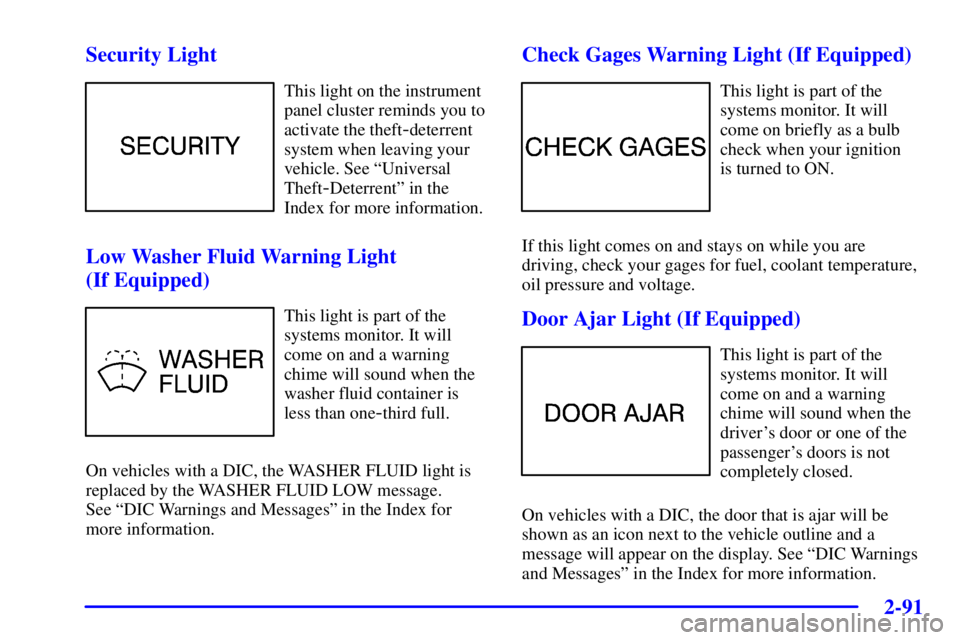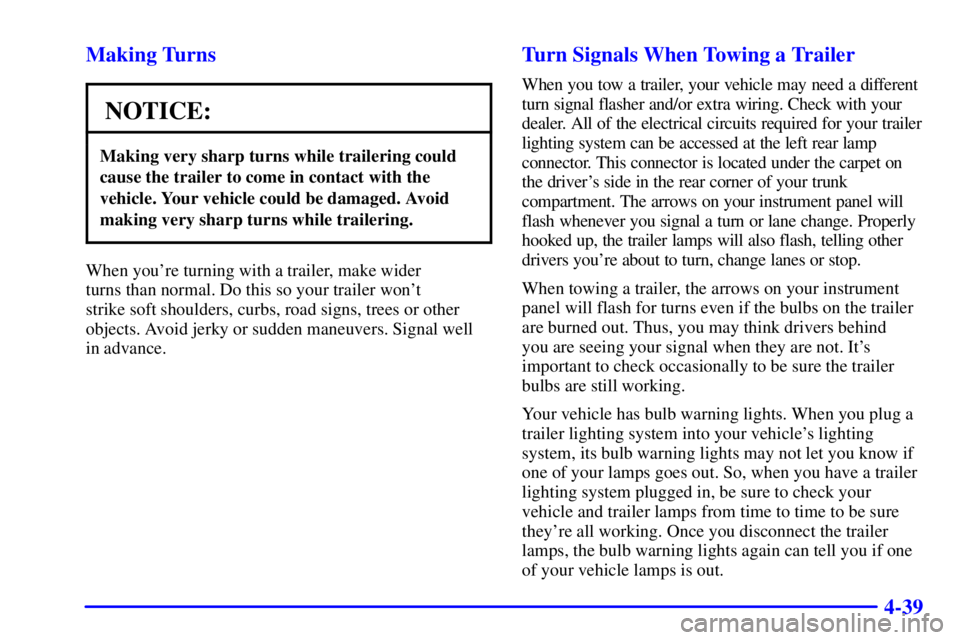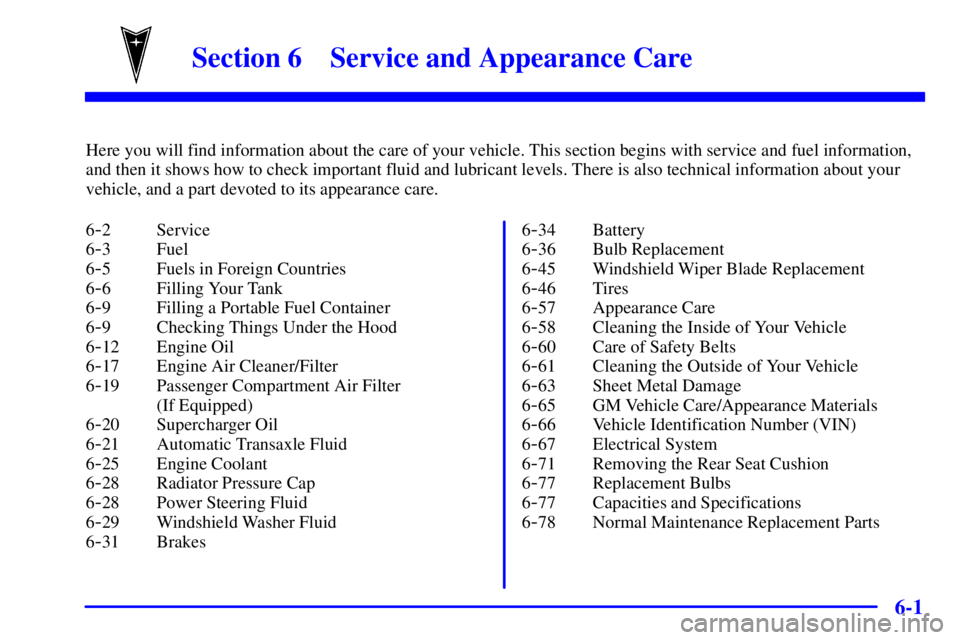Page 104 of 427

2-41 Turn and Lane-Change Signals
The turn signal has two upward (for right) and two
downward (for left) positions. These positions allow you
to signal a turn or a lane change.
To signal a turn, move the lever all the way up
or down. When the turn is finished, the lever will
return automatically.
An arrow on the instrument
panel cluster will flash in
the direction of the turn or
lane change.
To signal a lane change, just raise or lower the lever
until the arrow starts to flash. Hold it there until you
complete your lane change. The lever will return by
itself when you release it.
If the arrows flash very fast as you signal a turn or a lane
change, a signal bulb may be burned out and other
drivers won't see your turn signal.If a bulb is burned out, replace it to help avoid an
accident. See ªBulb Replacementº in the Index. If the
arrows don't go on at all when you signal a turn, check
the fuse. See ªFuses and Circuit Breakersº in the Index.
Turn Signal On Chime
If your turn signal is left on for more than 3/4 of a mile
(1.2 km), a chime will sound at each flash of the turn
signal. To turn off the chime, move the turn signal lever
to the off position.
Headlamp High/Low-Beam Changer
To change the headlamps from low beam to high beam,
push the lever forward. To change from high beam to
low beam, pull the turn signal lever toward you, then
release it.
When the high beams are
on, this light on the
instrument panel cluster
will also be on.
Page 153 of 427

2-90
Check Oil Level Warning Light
(If Equipped)
The CHECK OIL LEVEL
light is part of the systems
monitor. This light comes
on for five seconds as a bulb
check each time the ignition
key is turned to ON.
If the engine oil is more than 1.0 quart (0.9 L) low and
the engine has been shut off for at least eight minutes,
the CHECK OIL LEVEL light will come on and a
chime will sound the next time you start your vehicle.
If the CHECK OIL LEVEL light comes on, the engine
oil level should be checked at the dipstick then brought
up to the proper level, if necessary. See ªEngine Oilº in
the Index.
On vehicles with a DIC, the CHECK OIL LEVEL
light is replaced by an OIL LEVEL LOW message.
See ªDIC Warnings and Messagesº in the Index for
more information.
Service Vehicle Soon Light (If Equipped)
This light will come on
briefly as a bulb check
when your ignition is
turned to ON.
This light will come on and a warning chime will sound
if you have a certain non
-emissions related vehicle
problem. These problems may not be so obvious and
may not affect vehicle performance or durability.
Consult a qualified dealership for necessary repairs to
maintain top vehicle performance.
On vehicles with the supercharged engine and a
DIC, the SERVICE VEHICLE SOON light is
replaced by the SERVICE VEHICLE SOON message.
See ªDIC Warnings and Messagesº in the Index for
more information.
Page 154 of 427

2-91 Security Light
This light on the instrument
panel cluster reminds you to
activate the theft
-deterrent
system when leaving your
vehicle. See ªUniversal
Theft
-Deterrentº in the
Index for more information.
Low Washer Fluid Warning Light
(If Equipped)
This light is part of the
systems monitor. It will
come on and a warning
chime will sound when the
washer fluid container is
less than one
-third full.
On vehicles with a DIC, the WASHER FLUID light is
replaced by the WASHER FLUID LOW message.
See ªDIC Warnings and Messagesº in the Index for
more information.
Check Gages Warning Light (If Equipped)
This light is part of the
systems monitor. It will
come on briefly as a bulb
check when your ignition
is turned to ON.
If this light comes on and stays on while you are
driving, check your gages for fuel, coolant temperature,
oil pressure and voltage.
Door Ajar Light (If Equipped)
This light is part of the
systems monitor. It will
come on and a warning
chime will sound when the
driver's door or one of the
passenger's doors is not
completely closed.
On vehicles with a DIC, the door that is ajar will be
shown as an icon next to the vehicle outline and a
message will appear on the display. See ªDIC Warnings
and Messagesº in the Index for more information.
Page 261 of 427

4-39 Making Turns
NOTICE:
Making very sharp turns while trailering could
cause the trailer to come in contact with the
vehicle. Your vehicle could be damaged. Avoid
making very sharp turns while trailering.
When you're turning with a trailer, make wider
turns than normal. Do this so your trailer won't
strike soft shoulders, curbs, road signs, trees or other
objects. Avoid jerky or sudden maneuvers. Signal well
in advance.
Turn Signals When Towing a Trailer
When you tow a trailer, your vehicle may need a different
turn signal flasher and/or extra wiring. Check with your
dealer. All of the electrical circuits required for your trailer
lighting system can be accessed at the left rear lamp
connector. This connector is located under the carpet on
the driver's side in the rear corner of your trunk
compartment. The arrows on your instrument panel will
flash whenever you signal a turn or lane change. Properly
hooked up, the trailer lamps will also flash, telling other
drivers you're about to turn, change lanes or stop.
When towing a trailer, the arrows on your instrument
panel will flash for turns even if the bulbs on the trailer
are burned out. Thus, you may think drivers behind
you are seeing your signal when they are not. It's
important to check occasionally to be sure the trailer
bulbs are still working.
Your vehicle has bulb warning lights. When you plug a
trailer lighting system into your vehicle's lighting
system, its bulb warning lights may not let you know if
one of your lamps goes out. So, when you have a trailer
lighting system plugged in, be sure to check your
vehicle and trailer lamps from time to time to be sure
they're all working. Once you disconnect the trailer
lamps, the bulb warning lights again can tell you if one
of your vehicle lamps is out.
Page 296 of 427

6-
6-1
Section 6 Service and Appearance Care
Here you will find information about the care of your vehicle. This section begins with service and fuel information,
and then it shows how to check important fluid and lubricant levels. There is also technical information about your
vehicle, and a part devoted to its appearance care.
6
-2 Service
6
-3 Fuel
6
-5 Fuels in Foreign Countries
6
-6 Filling Your Tank
6
-9 Filling a Portable Fuel Container
6
-9 Checking Things Under the Hood
6
-12 Engine Oil
6
-17 Engine Air Cleaner/Filter
6
-19 Passenger Compartment Air Filter
(If Equipped)
6
-20 Supercharger Oil
6
-21 Automatic Transaxle Fluid
6
-25 Engine Coolant
6
-28 Radiator Pressure Cap
6
-28 Power Steering Fluid
6
-29 Windshield Washer Fluid
6
-31 Brakes6
-34 Battery
6
-36 Bulb Replacement
6
-45 Windshield Wiper Blade Replacement
6
-46 Tires
6
-57 Appearance Care
6
-58 Cleaning the Inside of Your Vehicle
6
-60 Care of Safety Belts
6
-61 Cleaning the Outside of Your Vehicle
6
-63 Sheet Metal Damage
6
-65 GM Vehicle Care/Appearance Materials
6
-66 Vehicle Identification Number (VIN)
6
-67 Electrical System
6
-71 Removing the Rear Seat Cushion
6
-77 Replacement Bulbs
6
-77 Capacities and Specifications
6
-78 Normal Maintenance Replacement Parts
Page 331 of 427
6-36
Bulb Replacement
For the type of bulb to use, see ªReplacement Bulbsº in
the Index.
For any bulb changing procedure not listed in this
section, contact your dealer.
Halogen Bulbs
CAUTION:
Halogen bulbs have pressurized gas inside and
can burst if you drop or scratch the bulb. You or
others could be injured. Be sure to read and
follow the instructions on the bulb package.
Headlamps
1. Reach behind the headlamp assembly, push in and
turn the bulb assembly counterclockwise to remove
the bulb assembly from the headlamp assembly.
Page 332 of 427
6-37
2. Lift the tabs to remove the bulb from the assembly.
3. Replace the bulb. Push the bulb assembly in and turn
it clockwise to install the bulb assembly into the
headlamp assembly.Headlamp Aiming
Your vehicle has a visual optical headlamp aiming
system equipped with horizontal aim indicators. The
aim has been preset at the factory and should need no
further adjustment. This is true even though your
horizontal aim indicators may not fall exactly on the
ª0º (zero) marks on their scales.
Page 338 of 427
6-43
4. Tip the headlamp assembly and while pressing the
release, turn the bulb and socket counterclockwise to
remove them.
5. Replace the bulb and reinstall the socket. Then
reconnect the wiring harness to the lamp assembly.6. Slide the lamp assembly back into place by lining up
the track on the bottom of the assembly with the
guide on the vehicle. Then connect the outboard snap
and secure the lamp assembly with the two bolts.